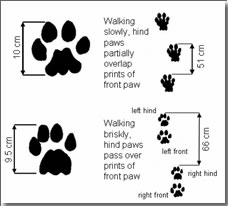

( Learn about our impact on animal habitats with your kids.) However, they are still threatened by human activities that encroach into their territories, destroying or fragmenting their habitats. Threats to survivalīobcats are classified as a species of least concern by the International Union for Conservation of Nature.
#BOBCAT VS COUGAR PAW PRINTS HOW TO#
They usually give birth to between one and six kittens, which remain with their mother for nine to 12 months, learning how to hunt and fend for themselves before setting out on their own. Males and females mate in February and March, and the young are usually born in April or May.įemales choose a secluded den-for example inside a cave or hollow tree stump-to raise their litter. Like other lynx, bobcats are solitary, territorial animals. They climb trees to catch prey, find a vantage point for a better view, or to escape from danger. When the time comes, they use their long, powerful hind legs to pounce on the animal-leaping up to 12 feet- and kill it with a bite to the throat.Īs well as being able to run in short, sharp sprints of up to 30 miles an hour, bobcats are strong swimmers and accomplished climbers. With their excellent eyesight, bobcats can spot prey from a distance and stalk it quietly while camouflaged. ( See first-ever photos of bobcat eating invasive python eggs.) They have even been caught fishing large salmon from a creek, and stealing eggs from a python’s nest. These skilled hunters eat rabbits, birds, mice, squirrels, and other smaller game, and are capable of killing prey much bigger than themselves, such as deer. This mother bobcat is trying to teach her young to hunt, but her cubs are reaping all the rewards! Diet and behaviorīobcats also have a more varied diet than other species of lynx, each of which tend to focus on one prey animal like the snowshoe hare for the Canada lynx and the European rabbit for Iberian lynx. Their coat helps them blend into their environment-an important trait for a stealth hunter. These cats range from gray to reddish-brown with dark spots and a white belly. They have thinner coats and smaller paws without any of the fur on their soles that other lynx use to keep warm and avoid slipping on icy pathways. In addition to being smaller than their lynx cousins with smaller tufts on their ears, bobcats tend to live in warmer climates, so they haven’t adapted to life in the snow. ( Learn more about all the lynx species.) The first is their short, black-tipped tail, which gives the species its name because it appears to be cut or “bobbed.” The tail’s coloring is also a clue: while the tip of a lynx’s tail is black all around, the underside of a bobcat’s tail is white. Appearanceīobcats share many similarities with the other lynx species-Canada lynx, Iberian lynx, and Eurasian lynx-but some distinct features set them apart. Though they may be the most common wildcat in North America, these elusive, nocturnal animals are rarely seen by humans. Bobcats can be found in forests, grasslands, swamps, deserts, and sometimes even roam into suburban areas. One of the four species of lynx, these wildcats are around twice the size of the average domestic cat and are fierce predators.įound throughout much of North America, they live in a diverse range of habitats. Current Population Trend: Stable What is a bobcat?īobcats may look cute and fluffy, but don’t be fooled into thinking they’re anything like a house cat.


 0 kommentar(er)
0 kommentar(er)
